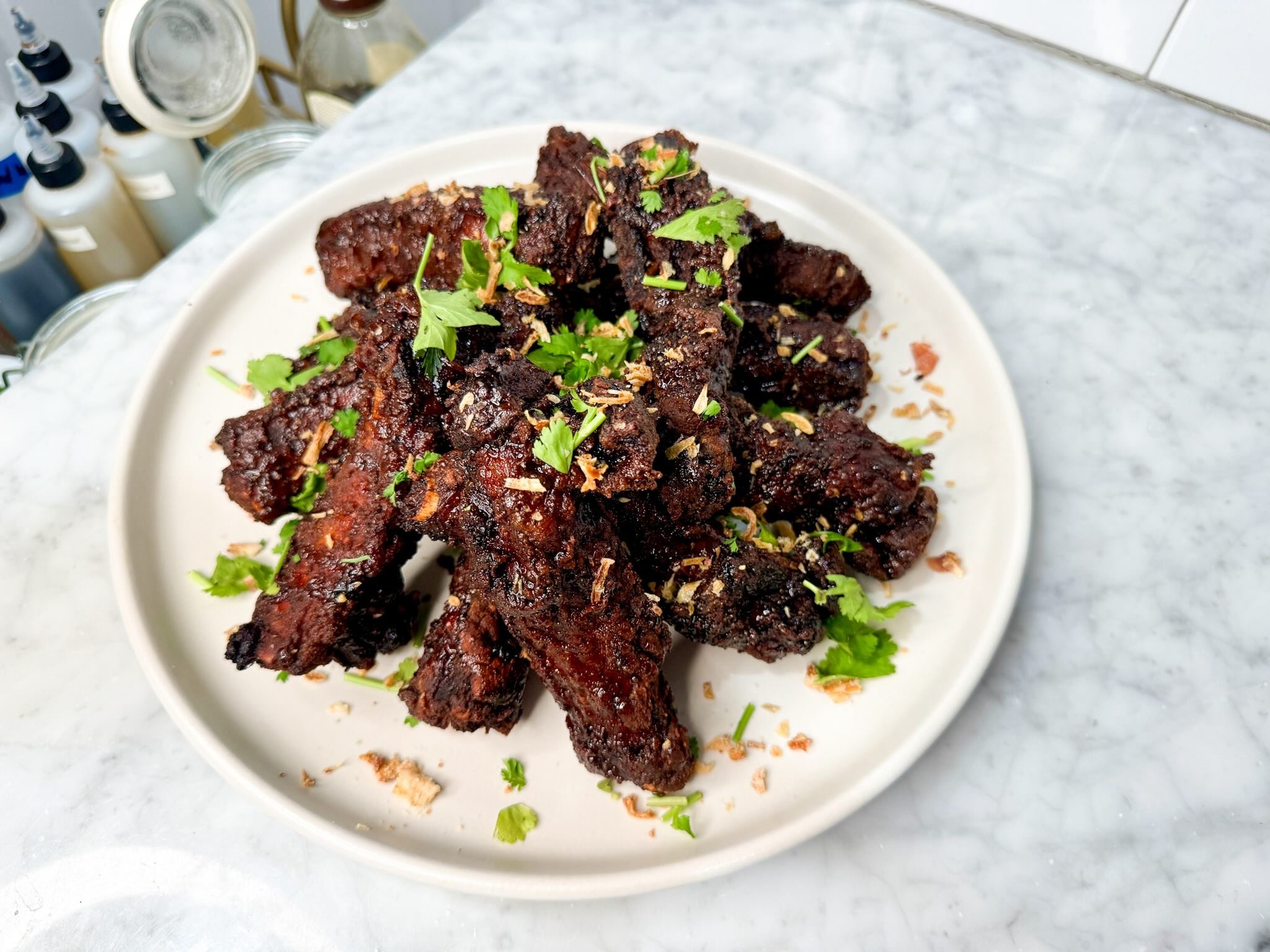Char Siu Fried Ribs
Pile the ribs high in the center of the plate. While the ribs are hot, douse them with your favorite toppings so they stick.
Smoking ribs are great but frying ribs are even better.
This recipe originates from one of my favorite blogs, Woks of Life, with the addition of a glaze. If you haven't explored their site yet, I highly recommend it—they offer a treasure trove of information on Cantonese and Chinese cooking. These ribs tend to disappear quickly when I put them on the table—they are crispy yet tender. Plus, I brush them with a glaze similar to the makings of char sui. To help you nail this recipe, here are some tips to ensure everything goes smoothly:
Remove the Silver Skin
Because we’re frying the ribs, I would recommend removing the silver skin from the ribs. Silver skin is a tough membrane found on the bone side of a rack of ribs. Slip a knife or a small, blunt tool under the edge of the silver skin at one end of the ribs, near a bone. Once you have a bit of the silver skin lifted, use your fingers to loosen it further. If it's slippery, you can use a paper towel to get a better grip. Gently pull the silver skin off the ribs in one go. It should come off relatively easily, but if it tears, just repeat the process with the remaining portion.
Marinate the Ribs in Fermented Tofu Overnight
Fermented bean curd is readily available at most Chinese grocery stores. Although its appearance might not be the most appealing, it delivers a deep umami flavor akin to a finely aged French cheese. My grandmother often adds a small piece when cooking water spinach. This preserved tofu, made from fresh bean curd, salt, rice wine, and other seasonings, comes in a red variety fermented with red yeast rice. Including fermented tofu in the rib marinade enhances the flavor, especially since the cooking time is relatively short.
Maintain the Cooking Oil Temperature
The secret to perfectly crispy fried food lies in keeping the cooking oil at a consistent temperature. To do this, start with fresh or slightly used oil, heat it in a heavy-bottomed pot, and adjust the heat as needed to maintain the right temperature. Use a candy thermometer or an instant-read thermometer to monitor the oil’s temperature. Avoid overcrowding the pot—fry no more than six ribs at a time. After each batch, let the oil return to 350°F before starting the next round. Finally, I like to flash fry everything together at the end to ensure all the ribs are served at the same temperature.
Ingredients for the Glaze
2 tablespoon hoisin sauce
2 tablespoons soy sauce
1 tablespoon honey
1/2 teaspoon Chinese five spice powder
Chopped cilantro, for garnish
Fried shallots, for garnish
Ingredients for the Ribs
2 pounds baby back ribs, approximately one rack, silver skin removed, sliced into individual ribs
2 cubes of red fermented bean curd, approximately 2 tablespoons
1/2 teaspoon ground white pepper
1/2 teaspoon MSG
1 teaspoon Chinese five spice powder
1 teaspoon sesame oil
1 tablespoon soy sauce
2 tablespoons Shaoxing wine
1 tablespoon of honey
1/2 teaspoon garlic powder
1/2 teaspoon onion powder
1/2 teaspoon baking soda
1/3 cup potato or corn starch
Canola or vegetable oil, for deep frying
Special Equipment
Wok or heavy bottomed Dutch oven
Tongs
Instant-read thermometer or candy thermometer
Pastry brush
Serves 4
Directions for the Glaze
Combine all of the ingredients and set aside to use once the ribs have cooked.
Directions for the Ribs
In a medium bowl, mash the fermented tofu pieces with a fork until smooth. Then, add the MSG, ground white pepper, five-spice powder, sesame oil, soy sauce, Shaoxing wine, honey, garlic powder, and onion powder. Stir well to combine all the ingredients. Once mixed, add the rib slices and baking soda, ensuring everything is evenly coated. For this, I like to use gloved hands.
Cover the ribs and let them marinate in the fridge overnight, or for at least four hours. Before cooking, take the ribs out of the fridge and let them sit at room temperature for an hour.
Fill a wok or Dutch oven halfway with cooking oil, then preheat the oil to 350°F degrees.
Give the ribs one final toss to redistribute the wet marinade before adding the potato starch. This helps the starch adhere more effectively. Using gloved hands, toss the ribs again to ensure each one is coated. The coating should be uneven and shaggy, not necessarily covering every part of the ribs.
Once the oil is heated up, add in four to six pieces of rib at a time to fry. Each piece should take around 5-7 minutes to cook. You’ll notice the color of the ribs getting darker because of the honey and soy sauce in the marinade. Adjust the heat as necessary to maintain a range of 325-350°F degrees. Once the ribs have cooked, transfer them to a tray lined with a rack or paper towels to allow them to cool.
Reheat the oil to 350°F degrees before adding the next batch of ribs, transferring each cooked batch to a rack as you go. After all the ribs are cooked, bring the oil back up to 350°F degrees once more and flash fry them all together for one to two minutes to ensure they're evenly heated. Place them back on the rack afterward.
Brush each rib with a bit of glaze, ensuring you coat the back side as well. For an optional garnish, sprinkle with chopped cilantro and/or fried shallots. Arrange the ribs on a plate, layering some on top of each other. Serve immediately and enjoy!
